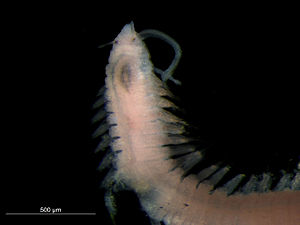Dorvilleidae
| Dorvilleidae | ||||||||||||
|---|---|---|---|---|---|---|---|---|---|---|---|---|

|
||||||||||||
| Systematics | ||||||||||||
|
||||||||||||
| Scientific name | ||||||||||||
| Dorvilleidae | ||||||||||||
| Chamberlin , 1919 |
Dorvilleidae is the name of a family of tiny to medium-sized polychaete (Polychaeta), which are common in oceans around the world and some of detritus feed, partly from plants, small animals and carrion.
features
The Dorvilleidae have a slender and cylindrical to spindle-shaped body. They reach lengths of about 250 µm in Neotenotrocha sterreri up to 10 cm in Dorvillea australiensis , which has about 150 segments when fully grown . The small, hemispherical to approximately conical prostomium bears a pair of more or less articulated antennae dorsolaterally and a pair of palps laterally , but both pairs of appendages can be reduced like papillae or rarely completely absent. Likewise, there is always a pair of indistinct nuchal organs on the prostomium , up to four eyes , which are missing in some species, and sometimes a nuchal papilla. The peristomium has two ringlets without tentacles and a ventral mouth with two protruding lateral lips. The evertable pharynx has chitin-containing jaws: ventrally a pair of rimmed and front-toothed, dark mandibles, dorsally maxillae with numerous tooth plates in two to four longitudinal rows, which are replaced every now and then. The parapodies are single-branched or indistinctly two-branched. If present, the notopodia have cylindrical cirrophores, an acicula and dorsal cirrus , the approximately conical neuropodia also have an acicula and ventral cirrus. The upper bristles of the neuropodia are simple, slender and capillary-shaped or acicular, sometimes short forked, the lower bristles of the notopodia are composed of short to long blades. The animals have no gills, but there are segmental rows of cilia . The anus sits dorsally on the pygidium with two to four anal cirrus nerves.
Most Dorvilleidae have metanephridia and a closed blood vessel system , as has been investigated in Dorvillea sociabilis and Ophryotrocha puerilis . The smallest forms such as Apodotrocha progenerans , on the other hand, have protonephridia and no blood vessel system.
habitat
The Dorvilleidae are distributed in oceans worldwide from shallow waters to the deep sea. Most species actively dig through sediment soils, shedding a lot of slime in the process. They are usually quite mobile on the substrate.
Development cycle
Most Dorvilleidae are segregated. Some species form swimming epitokes with enlarged eyes and more numerous and longer bristles for mating . In these species, like most Dorvilleidae, the gametes are released into the open sea, where fertilization takes place. The eggs develop as larvae (Polytrocha and Nectochaeta) over a rather short pelagic phase . Some smaller species of the genus Ophryotrocha are hermaphrodites that exchange their eggs for fertilization, lay them in tubular egg clutches and practice joint brood care by incubating these cocoons .
nutrition
Many Dorvilleidae are detritus eaters or substrate eaters , which digest the organic components of the swallowed sediment and excrete the mineral components unchanged. Schistomeringos loveni belongs to this group, but it can probably also drill its way into limestone from coral skeletons. Other species, especially in the genus Ophryotrocha , scrape off algae from the solid substrate with their pines . Many species of the Dorvilleidae are carnivores or scavengers . All species of the genus Iphitime and some in the genus Ophryotrocha live as commensals , possibly also as parasites in the gill cavities or on the carapace of decapods .
Genera
The following genera belong to the family Dorvilleidae :
- Anchidorvillea Hilbig & Blake, 1991
- Apodotrocha Westheide & Riser, 1983
- Apophryotrocha Jumars, 1974
- Arenotrocha Westheide & von Nordheim, 1985
- Coelobranchus Izuka, 1912
- Coralliotrocha Westheide & von Nordheim, 1985
- Diaphorosoma Wolf, 1986
- Dorvillea Parfitt, 1866
- Eliberidens Wolf, 1986
- Enonella Stimpson, 1854
- Eteonopsis Esmark, 1878
- Exallopus Jumars, 1974
- Gymnodorvillea Wainwright & Perkins, 1982
- Ikosipodoides Westheide, 2000
- Ikosipodus Westheide, 1982
- Iphitime Marenzeller, 1902
- Mammiphitime Orensanz, 1990
- Marycarmenia Nunez, 1998
- Meiodorvillea Jumars, 1974
- Microdorvillea Westheide & Von Nordheim, 1985
- Neotenotrocha Eibye-Jacobsen & Kristensen, 1994
- Ophryotrocha Claparède & Mecznikow, 1869
- Ougia Wolf, 1986
- Parapodrilus Westheide, 1965
- Parophryotrocha Hartmann-Schröder, 1971
- Parougia Wolf, 1986
- Petrocha Westheide, 1987
- Pettiboneia Orensanz, 1973
- Pinniphitime Orensanz, 1990
- Prionognathus
- Protodorvillea Pettibone, 1961
- Pseudophryotrocha
- Pusillotrocha Westheide & von Nordheim, 1985
- Schistomeringos Jumars, 1974
- Veneriserva
- Westheideia Wolf, 1986
Some authors such as Gregory Rouse and Fredrik Pleijel counted the genera Dinophilus , Apharyngtus and Trilobodrilus , but also Diurodrilus to the Dorvilleidae, but today these are usually placed in their own families Dinophilidae (first three genera) and Diurodrilidae .
literature
- Marian Hope Pettibone: Annelida. In: Sybil P. Parker (Ed.): Synopsis and Classification of Living Organisms , Vol. 2, pp. 1-43. McGraw-Hill, New York 1982. p. 21, Dorvilleidae.
- Stanley J. Edmonds: Fauna of Australia, Volume 4A. Polychaetes & Allies. The Southern Synthesis 4. Commonwealth of Australia, 2000. Class Polychaeta. Pp. 124-140, Family Dorvilleidae.
- Gregory Rouse, Fredrik Pleijel: Polychaetes . Oxford University Press, 2001. ISBN 978 0198506089
Web links
Individual evidence
- ↑ Gabriella Sella (1991): Evolution of Biparental Care in the Hermaphroditic Polychaete Worm Ophryotrocha diadema. Evolution 45 (1), pp. 63-68.
- ^ Dorvilleidae Chamberlin, 1919. WoRMS , 2018. Retrieved November 19, 2018.